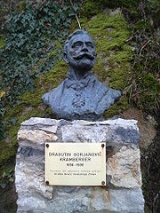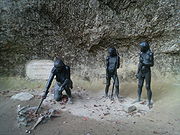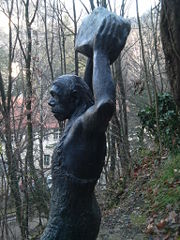
Dragutin Gorjanovic-Kramberger
Encyclopedia


Zagreb
Zagreb is the capital and the largest city of the Republic of Croatia. It is in the northwest of the country, along the Sava river, at the southern slopes of the Medvednica mountain. Zagreb lies at an elevation of approximately above sea level. According to the last official census, Zagreb's city...
, died December 24, 1936, Zagreb) was a Croatia
Croatia
Croatia , officially the Republic of Croatia , is a unitary democratic parliamentary republic in Europe at the crossroads of the Mitteleuropa, the Balkans, and the Mediterranean. Its capital and largest city is Zagreb. The country is divided into 20 counties and the city of Zagreb. Croatia covers ...
n geologist
Geologist
A geologist is a scientist who studies the solid and liquid matter that constitutes the Earth as well as the processes and history that has shaped it. Geologists usually engage in studying geology. Geologists, studying more of an applied science than a theoretical one, must approach Geology using...
, paleontologist, and archeologist.
Education
Dragutin finished his elementary education in Zagreb, CroatiaCroatia
Croatia , officially the Republic of Croatia , is a unitary democratic parliamentary republic in Europe at the crossroads of the Mitteleuropa, the Balkans, and the Mediterranean. Its capital and largest city is Zagreb. The country is divided into 20 counties and the city of Zagreb. Croatia covers ...
, as well as two years of preparandija (Faculty of Teacher Education, University of Zagreb). He started studying paleontology
Paleontology
Paleontology "old, ancient", ὄν, ὀντ- "being, creature", and λόγος "speech, thought") is the study of prehistoric life. It includes the study of fossils to determine organisms' evolution and interactions with each other and their environments...
in Zürich
Zürich
Zurich is the largest city in Switzerland and the capital of the canton of Zurich. It is located in central Switzerland at the northwestern tip of Lake Zurich...
, Switzerland. Soon, he moved to München, where his lecturer was Karl Zittel, a world-renowned expert in the areas of anatomy
Anatomy
Anatomy is a branch of biology and medicine that is the consideration of the structure of living things. It is a general term that includes human anatomy, animal anatomy , and plant anatomy...
and paleontology
Paleontology
Paleontology "old, ancient", ὄν, ὀντ- "being, creature", and λόγος "speech, thought") is the study of prehistoric life. It includes the study of fossils to determine organisms' evolution and interactions with each other and their environments...
. He received a doctoral degree in 1879, (Tübingen
Tübingen
Tübingen is a traditional university town in central Baden-Württemberg, Germany. It is situated south of the state capital, Stuttgart, on a ridge between the Neckar and Ammer rivers.-Geography:...
, Germany), with work related to fossilized fishes.
From 1880, he was curator
Curator
A curator is a manager or overseer. Traditionally, a curator or keeper of a cultural heritage institution is a content specialist responsible for an institution's collections and involved with the interpretation of heritage material...
at the Mineralogical Department of the Croatian National Museum and, in collaboration with his superior, archaeologist Đuro Pilar, he started mapping Mount Medvednica
Medvednica
Medvednica is a mountain in central Croatia, just north of Zagreb and marking the southern border of the historic region of Zagorje. The highest peak, at 1,035 m, is Sljeme. Most of the area of Medvednica is a nature park , a type of preservation lesser than a national park...
, (medvjed = bear, in Croatian
Croatian language
Croatian is the collective name for the standard language and dialects spoken by Croats, principally in Croatia, Bosnia and Herzegovina, the Serbian province of Vojvodina and other neighbouring countries...
), a mountain just north of Zagreb. In 1890 he changed his family name
Family name
A family name is a type of surname and part of a person's name indicating the family to which the person belongs. The use of family names is widespread in cultures around the world...
to Gorjanović.
Lecturing
His lecturing carer started in 1883 at the Faculty of Philosophy of the University of ZagrebUniversity of Zagreb
The University of Zagreb is the biggest Croatian university and the oldest continuously operating university in the area covering Central Europe south of Vienna and all of Southeastern Europe...
, where he taught paleontology of vertebrates. In 1884 he was appointed assistant, later was associate, and finally full professor, in 1896. In 1893 he became head of the Geological-Paleontological Department of the Croatian National Museum. He was engaged in paleontology
Paleontology
Paleontology "old, ancient", ὄν, ὀντ- "being, creature", and λόγος "speech, thought") is the study of prehistoric life. It includes the study of fossils to determine organisms' evolution and interactions with each other and their environments...
, stratigraphy
Stratigraphy
Stratigraphy, a branch of geology, studies rock layers and layering . It is primarily used in the study of sedimentary and layered volcanic rocks....
, tectonics
Tectonics
Tectonics is a field of study within geology concerned generally with the structures within the lithosphere of the Earth and particularly with the forces and movements that have operated in a region to create these structures.Tectonics is concerned with the orogenies and tectonic development of...
, paleoclimatology
Paleoclimatology
Paleoclimatology is the study of changes in climate taken on the scale of the entire history of Earth. It uses a variety of proxy methods from the Earth and life sciences to obtain data previously preserved within rocks, sediments, ice sheets, tree rings, corals, shells and microfossils; it then...
, applied geology
Geology
Geology is the science comprising the study of solid Earth, the rocks of which it is composed, and the processes by which it evolves. Geology gives insight into the history of the Earth, as it provides the primary evidence for plate tectonics, the evolutionary history of life, and past climates...
, geological mapping, and hydrography
Hydrography
Hydrography is the measurement of the depths, the tides and currents of a body of water and establishment of the sea, river or lake bed topography and morphology. Normally and historically for the purpose of charting a body of water for the safe navigation of shipping...
. Gorjanović-Kramberger discovered, described, classified, systemized, aged, and determined environments for numerous new species of fossilized fishes. As a young scientist at the end of 19th century, he had already published more than fifty works in prestigious European scientific journals.
Krapina
In 1899 on Hušnjak hill, near the Croatian town of KrapinaKrapina
Krapina is a town in northern Croatia and the administrative centre of Krapina-Zagorje County with a population of 4,482 and a total municipality population of 12,479...
, he discovered a very rich Neanderthal
Neanderthal
The Neanderthal is an extinct member of the Homo genus known from Pleistocene specimens found in Europe and parts of western and central Asia...
site of an early man today known as Krapina man (Krapinski pračovjek). News of the discovery quickly spread all around Europe and beyond. Gorjanović continued extensive scientific research of osteological human material, fauna, ecological conditions, and the life and culture of people once living in Croatia. While analyzing finds, he noticed unusually big variations among the bones.
With time he realized that evolution
Evolution
Evolution is any change across successive generations in the heritable characteristics of biological populations. Evolutionary processes give rise to diversity at every level of biological organisation, including species, individual organisms and molecules such as DNA and proteins.Life on Earth...
was the source of variability which created human individuals of different stature. His analysis and interpretation of fossil remains proved the existence of early humans which he called Homo primigenius, an ancestor of modern man. Latter on those finds were classified as Homo neanderthalensis. Gorjanović-Kramberger's research helped prove the theory of evolution of human species, and his theories have had an impact on the social view of the world.
He started the study of skeletons relating to modern humans and developed a techniques that analyzes the fluorine
Fluorine
Fluorine is the chemical element with atomic number 9, represented by the symbol F. It is the lightest element of the halogen column of the periodic table and has a single stable isotope, fluorine-19. At standard pressure and temperature, fluorine is a pale yellow gas composed of diatomic...
in bones to calculate their age. In 1895 he used newly-discovered X-rays to analyze inner bone structure. Results of his research related to the finds at Krapina could be found in the monograph
Monograph
A monograph is a work of writing upon a single subject, usually by a single author.It is often a scholarly essay or learned treatise, and may be released in the manner of a book or journal article. It is by definition a single document that forms a complete text in itself...
"O diluvijalnom čovjeku iz Krapine", (Der Diluviale Mensch von Krapina in Croatian; "On the diluvial man of Krapina"), which was published in Wiesbaden
Wiesbaden
Wiesbaden is a city in southwest Germany and the capital of the federal state of Hesse. It has about 275,400 inhabitants, plus approximately 10,000 United States citizens...
in 1906. The publication was the most comprehensive work ever written in the area of the paleontology of man.
Works
In 1909, he founded the Geological Commission for Croatia and SlavoniaSlavonia
Slavonia is a geographical and historical region in eastern Croatia...
, with the goal of carrying out geological mapping and research in pedology
Pedology (soil study)
Pedology is the study of soils in their natural environment. It is one of two main branches of soil science, the other being edaphology...
. The Croatian geological service became independent from the Geological Institute in Budapest
Budapest
Budapest is the capital of Hungary. As the largest city of Hungary, it is the country's principal political, cultural, commercial, industrial, and transportation centre. In 2011, Budapest had 1,733,685 inhabitants, down from its 1989 peak of 2,113,645 due to suburbanization. The Budapest Commuter...
and eventually became the present-day Hrvatski geološki institut (Croatian Geological Survey) in Zagreb.
Gorjanović-Kramberger published more than 230 papers in Croatian and international journals during his career. He made a couple of geological maps. He was an honorary doctor of the University of Zagreb, a member of the Association of Medical Doctors and Croatian Natural Sciences Association, and an honorary citizen of Zagreb, Karlovac
Karlovac
Karlovac is a city and municipality in central Croatia. The city proper has a population of 49,082, while the municipality has a population of 59,395 inhabitants .Karlovac is the administrative centre of Karlovac County...
, and Krapina. Gorjanović-Kramberger was a member of nine foreign scientific associations. From 1891, he was an associate member and from 1909 a full member of the then Yugoslav Academy of Sciences and Arts. Gorjanović-Kramberger remained active after his retirement. Between 1899 and 1929, he published 53 works related to discoveries at the Krapina site.
See also
- List of fossil sites (with link directory)
- List of hominina (hominid) fossils (with images)

